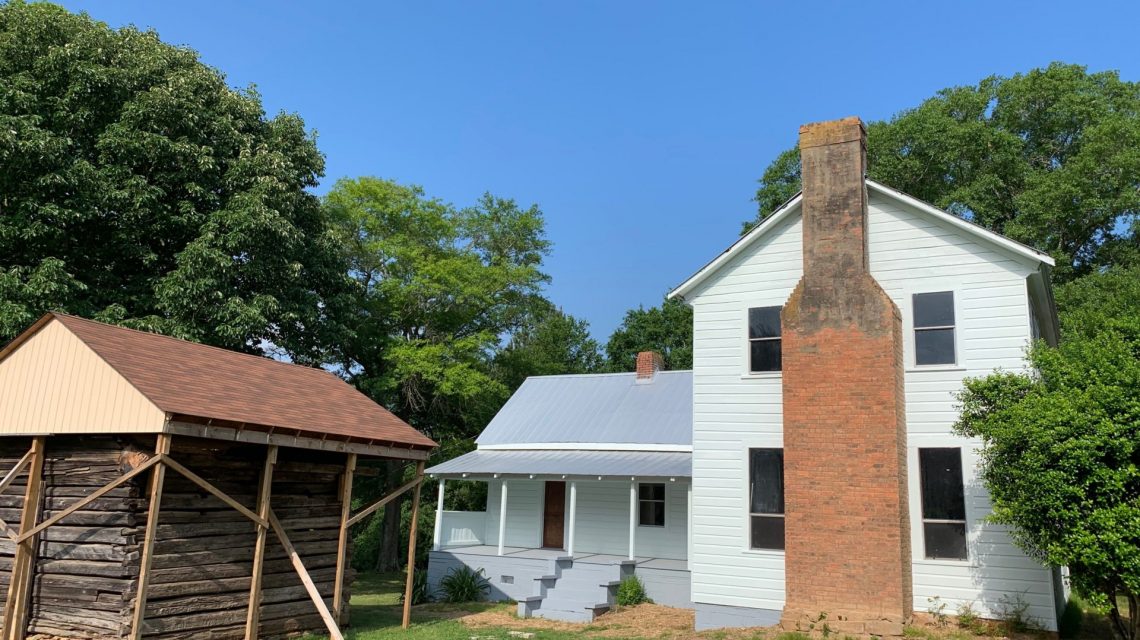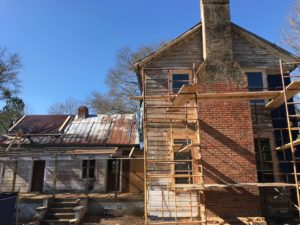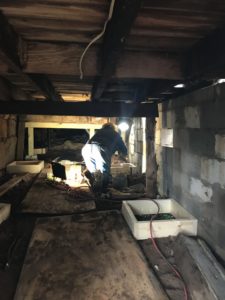Rejuvenating the Past: Historic Preservation Month in the AMNHA

 The historic legacy within the Arabia Mountain National Heritage Area encompasses hundreds – even thousands – of years of human activity. In 2018 we embarked on two major historic preservation efforts: the rehabilitation of Vaughters’ Farm and a major stabilization of the Lyon House, one of the oldest buildings in DeKalb County. Both projects ensured that these buildings will be around for years to come.
The historic legacy within the Arabia Mountain National Heritage Area encompasses hundreds – even thousands – of years of human activity. In 2018 we embarked on two major historic preservation efforts: the rehabilitation of Vaughters’ Farm and a major stabilization of the Lyon House, one of the oldest buildings in DeKalb County. Both projects ensured that these buildings will be around for years to come.
Vaughters’ Barn
DeKalb County was at one point the biggest dairy producer in the state of Georgia, and this grassy tract of farmland was part of a sprawling agricultural economy. Owned by S. B. Vaughters, the barn held cows and horses for most of the 20th century. As most of the surrounding landscape was filled with development, Vaughters sought a different future for his farm. “Nearly all the rest of DeKalb County is covered up with homes and businesses…I didn’t want that here,” he told the Atlanta Journal-Constitution in 2002. He sold his farm, including the barn and family home, to the Georgia Department of Natural Resources that same year; the land is now managed as part of Panola Mountain State Park. The barn, which sits adjacent to Klondike Road and the Arabia Mountain PATH trail, is a central feature of the AMNHA and a popular spot for photographs. (Please note that commercial photography requires a permit from park rangers.) Hiking trails meander through acres of former pasture that now act as a meadow and wildlife habitat.
One difficulty with preserving many agricultural buildings – even ones as imposing as Vaughters’ Barn – is that
these structures were not built to last. These utilitarian structures, common in their day, required constant upkeep and often changed with the changing needs of farmers (the barn held dairy cows, beef cattle and finally horses over the course of the years). Though much beloved by hikers and the community since becoming part of Panola Mountain State Park, by 2018 the barn was in much need of a makeover.
 Prior to the recent rehabilitation, the walls and roof of the barn were bowing outwards and parts of the building had sustained significant water damage. Beginning in November of 2018, workers repaired the interior, replaced windows, braced the roof and made other repairs to weatherproof and stabilize the aging structure. The restoration was completed in partnership with the Department of Natural Resources and the Arabia Mountain Heritage Area Alliance, the nonprofit arm of the AMNHA. The barn now stands stabilized and secure in its meadow, ready for hikers and park visitors to discover its history.
Prior to the recent rehabilitation, the walls and roof of the barn were bowing outwards and parts of the building had sustained significant water damage. Beginning in November of 2018, workers repaired the interior, replaced windows, braced the roof and made other repairs to weatherproof and stabilize the aging structure. The restoration was completed in partnership with the Department of Natural Resources and the Arabia Mountain Heritage Area Alliance, the nonprofit arm of the AMNHA. The barn now stands stabilized and secure in its meadow, ready for hikers and park visitors to discover its history.
Lyon Farm
The Lyon Family established their homestead in the shadow of Panola Mountain in the 1820s. For over 170 years, the family carved out a rural life where they cultivated crops and raised livestock. A log cabin was likely the first structure built on the property in the 1820s. The footprint was expanded multiple times over the years, creating the house that still stands today. The Lyon family were slave-owners and, prior to the Civil War, enslaved people worked most of this land. The homestead is the last remaining intact farm of what once made up the agricultural area called Flat Rock, which is today home to one of the oldest African-American communities in Georgia. 
The entire Lyon Farm, over 100 acres, was purchased by the DeKalb County Department of Watershed Management (DWM) in 2006 as part of the Pole Bridge Advanced Wastewater Treatment Plant and Sprayfields. In 2016, the property’s historic structures were placed on the Georgia Trust for Historic Preservation’s “Places in Peril” list due to excessive damage to the roof and other structural elements. Beginning in fall of 2018, the Arabia Mountain Heritage Area, DeKalb County DWM and contractors F. H. Paschen kicked off work on stabilizing the buildings.
The homestead needed major repairs. Workers started by building a framework around the smokehouse to hold up the outbuilding. Then, throughout the winter and spring, they spent time jacking, stripping, painting, leveling and generally fixing almost every part of the main house. That included raising the house to build a new system of supports beneath, securing a staircase to allow access to the second floor and repainting the entire building in its original white. Work finished in May of 2019.
With the completion of construction, the old farm and plantation site can act as a historical resource for visitors from around the world. The Flat Rock Archives begins a tour through the area’s African-American history at the site. “As one of the oldest structures in DeKalb County, it’s important that we preserve and study the history of the Lyon property,” said Mera Cardenas, Executive Director of the Arabia Mountain Heritage Area Alliance. Tours and educational signage will depict the full story of this piece of land, acting as a historical centerpiece of the National Heritage Area.
These two structures bookend critical transitions within the Arabia Mountain National Heritage Area: the beginning of European settlement in the area and the arrival of enslaved people, and the remnants of the dairy industry that faded with the sprawling growth of Atlanta. During Historic Preservation Month – and every month of the year – we treasure these physical remnants of this area’s past.

Construction on the Lyon House during stabilization efforts.

Major efforts had to be taken to shore up the Lyon House’s supports from the ground up.

